Article and photos by Joe Mish
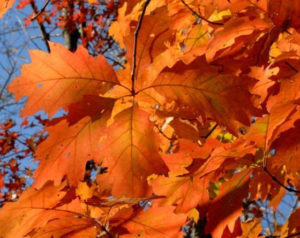
Black oak leaves are ablaze in the most incredible orange color, which makes you wonder how the black oak got its name.
A robe of many colors is October’s alone to wear. It is a coarse cloth, woven with silken threads of yellow and orange, melting into the extreme end of the red spectrum. Set against a clear blue sky, the colors radiate with brilliance. While the sun is otherwise occupied behind gathering clouds, the colors are no less extraordinary, as they hold their sharp contrast, presenting with a soft matte finish.
As the robe is placed upon the earth’s shoulders, the colors slowly flow downward in an infinitely slow progression, best seen from high above the earth. With that image in mind, it is easy to visualize autumn as a living creature leaving a momentary trail of color across the breadth of the tilting earth.
An alternative to a live, time lapsed satellite image of autumn’s gradual crawl across the latitudes, is best seen from a lofty vantage point with expansive views. Though the view is static, the full range of colors is on display. The cloth of the colorful cloak lies tight against the contour of the wooded mountains, each undulating feature of the landscape accentuated by shade and light. On a typical sunlit October day, herds of white billowy clouds drift across the blue sky followed on the ground by their shadows trying to keep up. As the lagging shadows flow across the colorful mountainsides, the tints change for a brief moment to provide a sense of movement to an otherwise still image. The scene is more dramatic if you can imagine the passing shadows being that of the artist’s hand working as you watch.
Retreating from distant views to stand within the October woodlands, individual trees and stands of trees become the focus. Each species resplendent in their own genetically defined color, modified to some degree by soil conditions, specifically, available nutrients and moisture. Instead of looking at a mass of treetops where smudges of varied colors blend together, we now see the pixels that make up the distant image.
Comparing trees of the same species, we can see the individual variation of color. Many trees with yellow leaves such as hickories, Norway maples, cherry and tulip poplar trees are very consistent in color. Oaks, sweetgum and some maples, whose leaves have a red component, show the most diversity.
The most glorious displays of fall color are where we find them, scattered among the local landscape. Each, an emissary heralding the arrival of autumn; apart from the mass of color sweeping across the land.
We all have a perennial favorite we watch on a daily basis to gauge the progress of autumn color.
A lone white oak in the middle of a field or a native red maple pressing against the chain link fence in the backyard, as seen from the bathroom window, serve as daily alerts.
Among the many autumn images accumulated in my experience, the one that keeps appearing is an old abandoned farm road lined with Norway maples, all the same size. The tree tops form a tight canopy over the road, keeping it clear of weeds and paving it with a golden carpet of fallen leaves. The length of the yellow paved road has a hint of a vanishing point that beckons a traveler to follow deeper into the fire of autumn color.
Author Joe Mish has been running wild in New Jersey since childhood when he found ways to escape his mother’s watchful eyes. He continues to trek the swamps, rivers and thickets seeking to share, with the residents and visitors, all of the state’s natural beauty hidden within full view. To read more of his writing and view more of his gorgeous photographs visit Winter Bear Rising, his wordpress blog. Joe’s series “Nature on the Raritan, Hidden in Plain View” runs monthly as part of the LRWP “Voices of the Watershed” series. Writing and photos used with permission from the author.
Article and photos by Joe Sapia
Note: The yard references are to my house in the section of Monroe between Helmetta and Jamesburg in South Middlesex County. My yard is in a Pine Barrens outlier on the Inner Coastal Plain, the soil is loamy, and my neighborhood is on the boundary of Gardening Zones 6b (cooler) and 7a (warmer). Notes and photographs are for the period covered, unless otherwise noted.
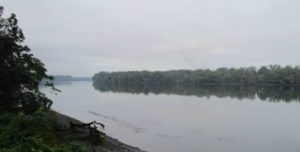
Dawn on the Delaware River, looking downstream from Hamilton, Mercer County, to the other side of the river and Bucks County, Pennsylvania.
ABBOTT MARSHLANDS: The Abbott Marshlands are about 3,000 acres, about 1,300 wetlands and 1,700 uplands, along the Delaware River on the boundary of Burlington and Mercer counties in the Bordentown-Trenton area. An interesting point of the marsh is that it is both freshwater and tidal. While Delaware River saltwater going inland ends between the Delaware Memorial Bridge and Philadelphia, the tidal effect continues for miles upstream to the Marshlands. The Marshlands also are known as the Trenton Marsh and the Hamilton Marsh. More information is at http://abbottmarshlands.org/.
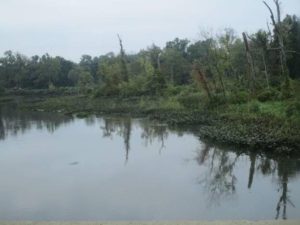
The Abbott Marshlands at Hamilton, Mercer County.
MONARCH BUTTERFLIES: Watch for monarch butterflies, “Danaus plexippus,” on their southern migration, to either Florida or, more likely, Mexico. This “super generation” are the great-grandchildren of last fall’s migrators and will make the complete migration. However, next year, they will begin northward, but will only make it so far, requiring three breedings to complete the journey north. Then, those great-grandchildren will become a “super generation,” making the entire journey south.
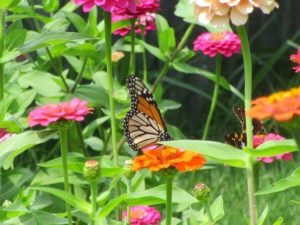
A monarch butterfly in my garden in August.
DRIVE-BY NATURALIST, BLACK VULTURES: I was driving to Princeton, Mercer County, to meet the lovely Pamela for breakfast and came across quite a scene on Route 27 in South Brunswick, Middlesex County – dozens of black vultures, “Coragyps atratus,” feeding on a dead deer. (As I mentioned last month, I do not recall seeing a black vulture locally until probably the 1990s. They are a southern species that has moved north.) Remember, nature is all around us, just keep an eye out for it.
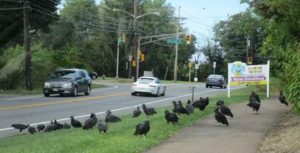
Black vultures on Route 27 in South Brunswick, Middlesex County.
DRIVE-BY NATURALIST, CHESTNUT TREES: As I was driving through the Pine Barrens around Helmetta, I noticed a Middlesex County Parks and Recreation pickup at the Jamesburg Park Conservation Area. I had to talk to naturalist Eric Gehring about a volunteer project, so I turned around and pulled over. Eric was on a mission with Les Nichols of the American Chestnut Foundation, looking for chestnut trees, “Castanea dentata,” in the Conservation Area. Since around 1900, the American chestnut has been plagued by a non-native and extremely invasive and potent fungal blight, “Cryphonectria parasitica,” – estimated to have crippled up to 4 billion chestnuts initially. American Chestnut blight affects the tree upward from where it infects it. The tree, then, is able to sprout again from roots, only to have those shoots, except for rare cases, infected. The Foundation seeks good specimens, hoping to create resistance in future chestnuts. Eric asked if I knew of chestnuts growing in these woods. Yes, at Swing Hill (which Eric already knew about) and at Big Tree. Into the woods, we headed – on my part unexpectedly, but I would rather walk the woods my family has walked for more than 100 years than do chores around the house – looking for specimens that may produce sought-after seeds in the future.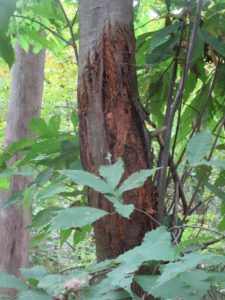
An American chestnut, in the Pine Barrens around Helmetta, infected with the fungal blight.
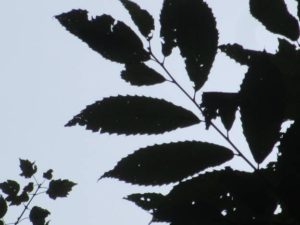
American chestnut leaves in silhouette – serrated with a surf wave-like pattern.
STINK BUGS: I had noticed one or two brown marmorated stink bugs, “Halyomorpha halys,” outside the house. This is an Asian species, apparently introduced accidentally in the Allentown, Pennsylvania, area in 1996. This week, I found one in the house on a blind in my living room — perhaps just the beginning of an infiltration for their overwintering. As a Rutgers University fact sheet says, “They enter houses through cracks in windows and the foundation and may be seen in large numbers during September and October.” If you go after one and, say, crush it, it will release an earthy odor. So, it is a nuisance, not a damaging bug to the house. However, it is a serious threat to crops. More information is available at https://njaes.rutgers.edu/stinkbug/. (As for crickets in the house, my $45,000 cricket deterrent project – that is the remodeling with the side benefit of keeping crickets out of the house – seems to be working. So far, only 8 crickets in the cellar and 2 in the living section of the house. A cacophony of crickets is beautiful music. A single cricket rubbing its legs in the wee hours like the fingernail scratching of a blackboard. While cleaning the garage, I may have discovered their last main intrusion route into the living section – through a crack/opening between garage floor and foundation.)
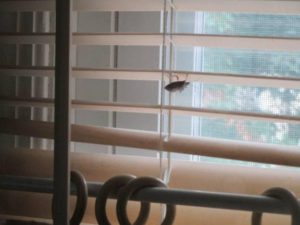
marmorated stink bug on a living room blind.
BIRD FEEDING: This is the first summer in years I have not gone all out feeding the birds in my yard. I miss watching them, but I saved quite a bit of money (because I use only sunflower hearts or kernels) and tried something new, letting the birds eat insects, serving as a natural pesticide. But the bird-feeder is back up and the birds are slowly discovering it. I am looking forward to beginning my day watching birds feed.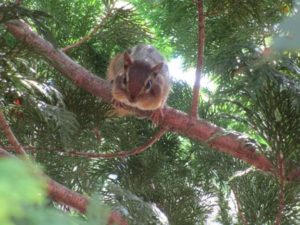
A chipmunk, “Tamias striatus,” in the yard.
FERRIS FARMS: Now that I am feeding the birds in my yard again, I stopped by my regular bird food supplier, Ferris Farms in East Brunswick, Middlesex County. I recall visiting Ferris as a youngster with my family. Mike Rutkowski and Tony Riccobono have always been friendly and helpful when I have asked gardening questions. See http://www.ferrisfarms.org/.
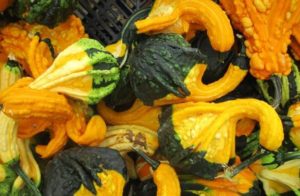
Gourds at Ferris Farms in East Brunswick, Middlesex County.
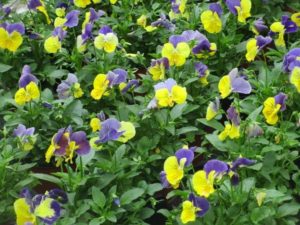
Pansies at Ferris Farms.
KITCHEN TABLE: The flower display on my kitchen table gets better and better. One, the Knock Out roses continued flowering. Two, the zinnias also continued blooming. Three, I learned the display looked better with the more zinnias that I used. Lastly, the gourds were the same as before but they seemed to be yellowing in color, making them more autumn-like. Of course, the antique, porcelain-top table adds to the country-ness of the display. On the down side, this rose bloom seems on its way out. (I have something up my sleeve, though: Grandma Annie Onda’s old kitchen table, with porcelain top and more ornate build, stands ready in my cellar to be moved upstairs to the kitchen.)
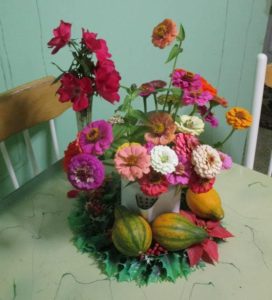
The kitchen table flower display.
ZINNIAS IN THE GARDEN: This week, my zinnias were distributed to the Helmetta Post Office, the lovely Pamela’s, and Jamesburg Dental Care (where I had my first dental appointment 55 years ago under Dr. Lew Goldstein). Butterflies continue to visit my zinnia patch.
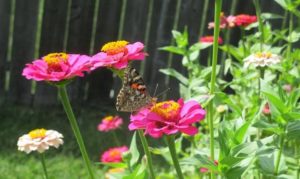
A painted lady, “Vanessa cardui,” in the zinnia patch.
HURRICANE JOSE, THE GOOD: Jose’s effects brought out sightseers to look at the roughness of the ocean. And I saw parasailing surfers taking advantage of the winds at the Atlantic Ocean at Sea Bright, Monmouth County.
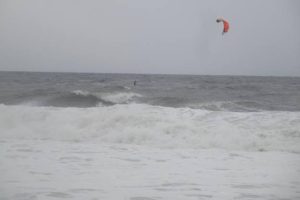
A parasailing surfer in the Atlantic Ocean at Sea Bright, Monmouth County.
WEEDS IN THE YARD: When I see some kind of vegetation popping up in the yard, I let it grow to observe it. So, year after year, pokeweed, “Phytolacca americana,” pops up, one plant along my driveway, another in my garden. Here is an interesting article on this complicated plant, http://nadiasyard.com/our-native-plants/american-pokeweed/.
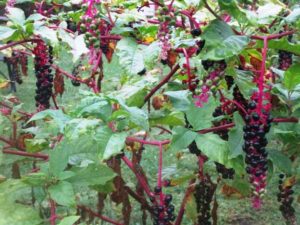
Pokeweed in the garden.
MONMOUTH CONSERVATION FOUNDATION: A shout-out to the Monmouth Conservation Foundation, a not-for-profit land preservation group in Monmouth County, as it celebrates its 40th anniversary. Over the 40 years, it has helped save more than 22,000 acres of open space. (The Foundation recently contracted me to write two articles – one on the group’s origin and another on Monmouth County wildlife — for one of its upcoming publications.)
OCEAN TEMPERATURES: Atlantic Ocean temperatures on the New Jersey coast were about 69 degrees to 74 degrees on the weekend of September 23-24.
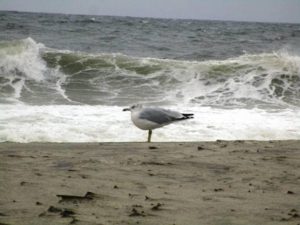
A gull at the Atlantic Ocean beach at Sea Bright, Monmouth County.
SUNRISE/SUNSET: For September 24, Sunday, to September 30, Saturday, the sun will rise about 6:50 a.m. and set about 6:45 p.m. For October 1, Sunday, to October 7, Saturday, the sun will rise about 6:55 to 7 a.m. and set about 6:30 to 6:40 p.m.
THE NIGHT SKY: The next full moon is the Full Harvest Moon October 5, Thursday.
WEATHER: The National Weather Service forecasting station for the area is at http://www.weather.gov/phi/.
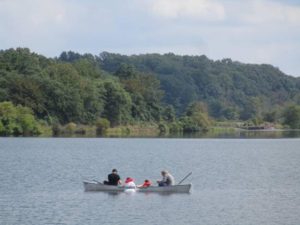
“Jamesburg Lake,” or more properly “Lake Manalapan,” on the boundary of Monroe and Jamesburg, Middlesex County, is about 35 to 40 acres. On the Outer and Inner Coastal Plains, there are few, if any, natural bodies of water. So, Jamesburg Lake on the Inner Coastal Plain is formed by the damming of Manalapan Brook.
Joe Sapia, 60, is a lifelong Monroe resident. He is a Pine Barrens naturalist and an organic vegetable-fruit gardener. He gardens the same backyard plot as did his Italian-American father, Joe Sr., and his Polish-immigrant, maternal grandmother, Annie Poznanski Onda. Both are inspirations for his food gardening. Joe is active with the Rutgers University Master Gardeners/Middlesex County program. He draws inspiration on the Pine Barrens around Helmetta from his mother, Sophie Onda Sapia, who lived her whole life in these Pines, and his Grandma Annie. Joe’s work also is at @JosephSapia on Twitter.com, along with Facebook.com on the Jersey Midlands page.
Article and maps by Sophie Benaroya, Rutgers University Sophomore
This summer I worked in Dr. JeanMarie Hartman’s Lab at Rutgers University researching factors that affect infiltration rates. More specifically I looked into how soil health indicators compare with infiltration rates in New Jersey’s Lower Raritan Watershed.
Soil health and infiltration rates are important because of their wide-reaching effects. Soil health affects groundwater, surface runoff (and hence flooding), and vegetative productivity. Unhealthy soil can lead to contaminated groundwater and waterways, a decrease in arable land, a decrease in forests and an increase in flooding risk. There are many factors that affect soil health, infiltration being one of them. Soil can be impacted by organic matter content (animal and plant matter in various stages of decomposition), soil fragments (rock fragments larger than a grain of sand) and amount of impervious surface – like roads, pavements and parking lots, and land use. Previous research has shown that urbanization has a major impact on soil health, and due the fact that the Lower Raritan Watershed is mostly urban land I felt it would be interesting to see how urbanization may have affected the soil.
To research the topic, data was downloaded from the Web Soil Survey, the official source of soil data for the United States. I analyzed these data using ArcGIS, a mapping software, and Microsoft Excel. Data on various chemical, physical and water properties on soil in the Lower Raritan Watershed was downloaded and compared to infiltration rates. As there is no data on infiltration as is; saturated hydraulic conductivity and hydrological soil groups were used as surrogates (this decision was based on the recommendations of professionals in the field). The factors that were researched were organic matter content, percentage of fragments in soil, bulk density (how compact the soil is), surface runoff class (the amount of water flow on land and is not absorbed into the soil), impervious surface cover, and land use.
First, I compared saturated hydraulic conductivity and land use. This comparison, as well as the tabular data, showed that urban areas have lower saturated hydraulic conductivity levels than Forest, Wetland and Agricultural areas.
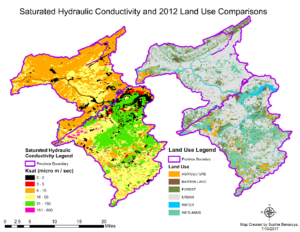
Figure 1: Saturated Hydraulic Conductivity and Land Use Comparisons
Then I compared hydrological soil groups with soil fragments percentages in the soils (Figure 2, below). Hydrological Soil Groups are groups that soil is placed in based on its surface runoff class, saturated hydraulic conductivity, and infiltrometer data. There are five classes as follows: A – High infiltration, B – Moderate infiltration, C – Slow infiltration, D – Very slow infiltration, and A/D, B/D, C/D – Dual soil groups (first letter represents drained areas, second letter represents un-drained areas.) It is evident from the map that soils with a percentage of fragments of 28% and above generally fall under soil group “D”, further insight into tabular data showed that 58.39% of soil in group D have over 28% fragments. Soil groups A and B had the majority of their soils have 6% or less fragments.

Figure 2: Hydrological Soil Groups versus Soil Fragments %
I then looked at saturated hydraulic conductivity versus surface runoff class comparisons. In this analysis (see Figure 3 below) I compared the relationship between saturated hydraulic conductivity and surface runoff class. Saturated hydraulic conductivity is very high (51-150 micro meters/sec) in soils with negligible, very low and low surface runoff. The medium level of hydraulic saturated conductivity is generally lower in the medium, high and very high classes.
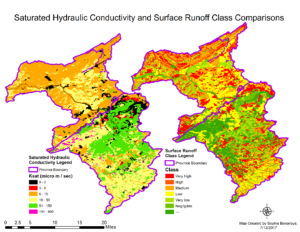
Figure 3: Saturated Hydraulic Conductivity versus Surface Runoff Class Comparisons
Then I looked at saturated hydraulic conductivity and impervious surface percentage comparisons.
Figure 4 below compares the relationship between saturated hydraulic conductivity and impervious surface percentage. As impervious surface increases, high rates of conductivity (6-15 and 51-150 micro meters/sec) decrease in frequency.
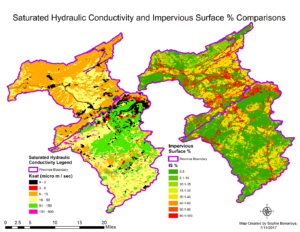
Figure 4: Saturated Hydraulic Conductivity and Impervious Surface % Comparisons
Finally I looked at the breakdown of impervious surface percentage in natural, hydric and urban soils. Figure 5 below shows that over 98% of both hydric and natural soils have 0-5% impervious surface, compared with only 13.51% of urban soils.
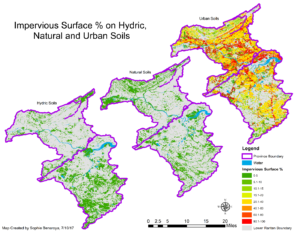
Figure 5: Impervious Surface % on Hydric, Natural and Urban Soils
Through my research I found that unfavorable levels of indicators were linked to lower levels of infiltration. The most interesting finding was the effect of land use on soil health. Urban land had lower infiltration rates than forests, wetlands and agricultural areas. In addition, urban lands had low levels of organic matter, high levels of soil fragments and, high levels of impervious surface. The increase in impervious surface is linked to urbanization. Natural and hydric soils in the Lower Raritan Watershed had less than 5% of their soils exhibit impervious surface cover of 5% or more, compared to almost 75% of urban soils. However, not all urban land uses had the same levels. Athletic fields, recreational land and cemeteries had higher levels of infiltration than military or industrial land; possible because they have more vegetation.
Another important finding had to do with forests. Forests and wetlands have high infiltration rates, however in the Piedmont province there is more fragmentation and as such those forests and wetlands typically have lower levels of infiltration than forests and wetlands in the Coastal Plains province. This means that an increase in the fragmentation of forests potentially due to urbanization would be detrimental to soil health, as forests in the Piedmont have an average saturated hydraulic conductivity rate of 18.52, whilst forests in the Coastal Plains province have an average of 53.21.
The main take-aways from my research is that protection of forested areas could help prevent soils from worsening, and an increase in planting in and around current forest areas could help improve the soil of current patches. An increase in green infrastructure could also be beneficial in improving urban soils by increasing the vegetative cover, organic matter and reducing surface runoff.
Article and photos by Joe Sapia
Note: The yard references are to my house in the section of Monroe between Helmetta and Jamesburg in South Middlesex County. My yard is in a Pine Barrens outlier on the Inner Coastal Plain, the soil is loamy, and my neighborhood is on the boundary of Gardening Zones 6b (cooler) and 7a (warmer). Notes and photographs are for the period covered, unless otherwise noted.
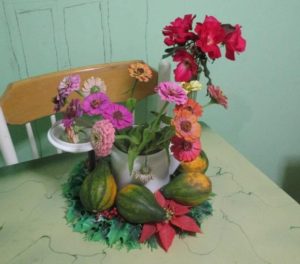
My kitchen table display gets better and better: Gourds, which mysteriously appeared in the garden, are added to the display of zinnias and Knock Out roses on the antique porcelain-top table.
BIG SKY COUNTRY, EMLEY’S HILL: I was driving through one of my favorite places in the Midlands, rural Western Monmouth County. I stopped at Upper Freehold’s Emley’s Hill, part of the cuesta geological formation that divides the Outer and Inner Coastal Plains. Generally, east of this hilly formation drains directly to the Atlantic Ocean, while west of the cuesta drains to the Raritan River. Emley Hill, though, is on a spur of the cuesta dividing the drainages of the Raritan River and the Delaware River. Because it is a hilly rural area at about 140 feet above sea level with lower surrounding farmland, there are beautiful big-sky views. Emley’s Hill is at the intersection of Emley’s Hill Road and Burlington Path Road.
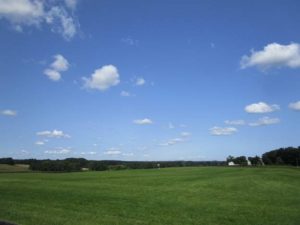
Looking east from Emley’s Hill in Upper Freehold, Monmouth County.
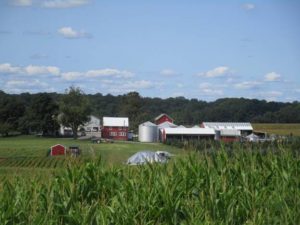
Looking north from Emley’s Hill at the Bullock Farms, http://www.bullockfarms.com/.
WILD OUTDOOR EXPO: The New Jersey Wild Outdoor Expo is an annual event, held at the Colliers Mills Wildlife Management Area in Ocean County. It includes information on environmental issues and parks, hunting, fishing, trapping, other recreational use of the outdoors, and so on.
This year’s expo, held on Saturday and Sunday, September 9 and 10, was sponsored by the state Department of Environmental Protection’s Division of Fish and Wildlife, Division of Parks and Forestry, and Forestry Services, along with the Conserve Wildlife Foundation of New Jersey.
Colliers Mills WMA is the almost 13,000 acres of open space — Pine Barrens forest, fields, waterways, and bodies of water — behind the Six Flags/Great Adventure amusement area. Outside of New Jersey, WMAs are referred to as “game lands.” In New Jersey, WMAs are shared by hunters and other recreational outdoors people.
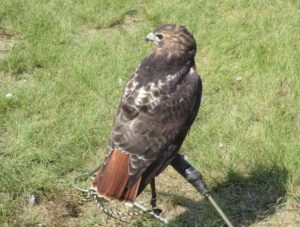
Red-tailed hawk, “Buteo jamaicensis,” on display at the Expo. Note the reddish tail giving the hawk its name. Red tails are commonly seen, soaring above, or commonly heard, calling in a wheezy-sound way.
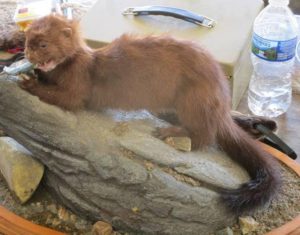
A mounted mink, “Mustela vison.” They are around, but the only two I have seen were both roadkills in recent years in the Pine Barrens around Helmetta.
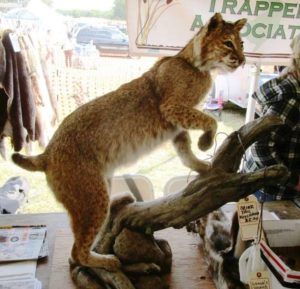
A mounted bobcat, “Lynx rufus.” I describe them as having a dog-like body with a cat’s head. I would love to see one in the wild. The state lists the bobcat as “endangered,” or in immediate peril of surviving.
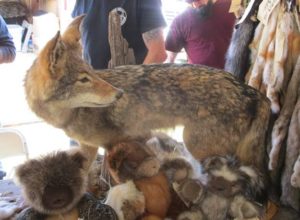
A mounted coyote, “Canis latrans.” Note the dog-like body, but pointy fox-like nose and ears. From 2014 to 2016, I worked an overnight shift near the Metropark train station in Woodbridge, Middlesex County, and I would occasionally see a coyote. One night, an ambulance was on the other side of the woods, yipping its siren. The coyotes started up, yipping away. Smart animals – I once read a suggestion if coyotes had opposing toes, they probably would run the world.
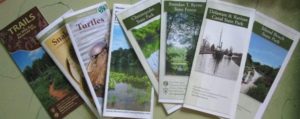
Brochures from the Expo.
FALLING ACORNS: I was driving one of the paved roads through the Jamesburg Park Conservation Area in the Pine Barrens around Helmetta and came across outdoorsman Art Utter, who lives nearby in Spotswood. Art was gathering acorns to use as hunting bait around his deerstand. While we were talking, I was listening to and dodging falling acorns. Earlier, Art got conked on the head by one and it drew blood. These things looked massive. Some might say these acorns suggest a severe winter ahead, with the acorns providing animals with food. I do not think it is a good predictor of anything. The only thing I got out of it was that it seemed as though acorns were falling steadily and they were big.
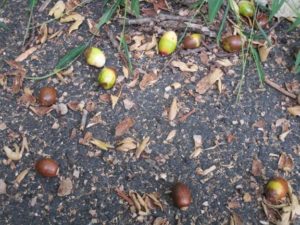
Acorns litter a road in the Jamesburg Park Conservation Area in the Pine Barrens around Helmetta.
IN THE GARDEN: I got tired of looking at the tangle of cucumber and cantaloupe plants that did not produce one usable item this year. So, I mowed them down, along with the tomatillos and gourds, both of which I did not plant. So, now, I look forward to fall lettuce, which is growing nicely, and carrots.
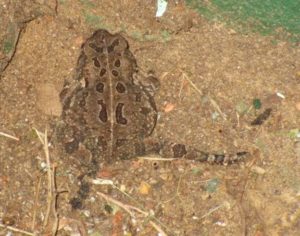
I came across this toad, genus “Anaxyrus,” while cutting the lawn.
THE FLOWERING YARD: The zinnias and Knock Out roses continue to bloom, although the zinnias may have slowed down – perhaps because of powdery mildew and leaf spot. But the Knock Outs seem to be flourishing.
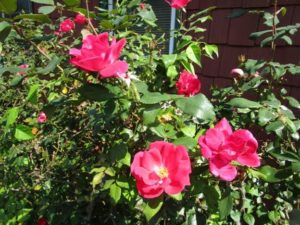
Knock Out roses continue to bloom nicely – even flourishing.
OUT-OF-SEASON FLOWERING: Occasionally, plants bloom out of season. In the past, I remember seeing sheep laurel, “Kalmia angustifolia,” blooming in the fall in the Pine Barrens around Helmetta, when its normal bloom is May and June. Maybe an out-of-season bloom was caused by temperatures and sunlight replicating normal bloom times. Whatever the reason, the flowering quince bush in my yard was actually flowering. Normal flowering would be in the spring.
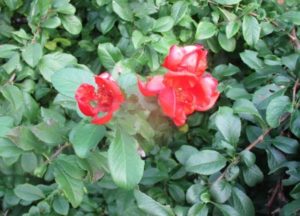
Flowering quince blooming out of season.
BIZARRE EXPERIENCE IN THE YARD: The flowering quince was unusual, but not bizarre. The bizarre experience happened a day earlier, when I was cutting the front yard grass. First, I notice a rabbit, “Sylvilagus floridanus,” watching me from a few feet away on the other side of the hedges. As I have mentioned, if I go about my own business, the rabbits and butterflies allow me to get close. As I was cutting the grass along the street’s edge, I noticed something embedded in the ground where I had just mowed – a 20-gauge, loaded shotgun shell! If I cut that open when I was mowing, I could have sprayed hundreds of pellets. Fortunately, it was intact, but bent, probably having been run over by a vehicle. In the old days, I could have asked any of a number of hunters in the neighborhood what to do. But hunting is becoming less popular, so less available sources. Although it was probably remote I could set off the primer and powder, I did not want to take a chance. So, I called Monroe Police and gave it to responding Officer Bob Bennett with whom I had a great conversation about the local woods. (Officer Bennett opened the conversation, asking if I was the guy…. Uh, oh, a police officer asking if I was the guy! Actually, he asked if I was the guy who posts nature photographs on the local Facebook page. Guilty, Officer. I mean, Yes, Officer.) As for the shotgun shell, who knows where it came from. My friend, the rabbit, disappeared. Was it warning me about the shell?
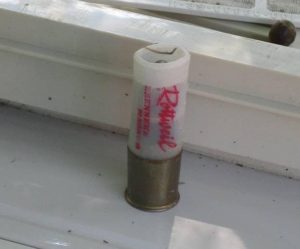
The shotgun shell.
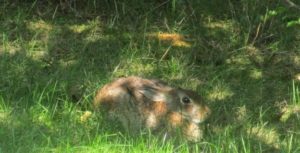
My rabbit friend. Was it warning me about the shotgun shell?
FLOWERING HIGHTSTOWN: One of my regular stops is the Hightstown Diner, where Kathy and George Antonellos have been great hosts over the decades in their 1941 diner. What I notice when I visit the diner is the flowers in this quaint, historic Mercer County town. So, I walked about, shooting photos of them. (If you like South Jersey-Philadelphia scrapple, the Hightstown Diner has it – one of the northernmost locations where scrapple can be found. Me, I love scrapple!)
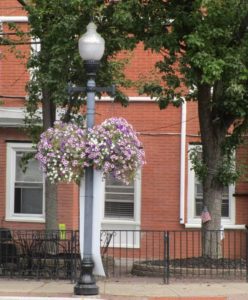
The corner of Mercer Street (Route 33) and Rogers Avenue in Hightstown, Mercer County.
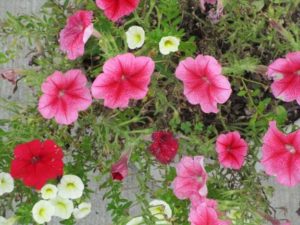
Along Mercer Street (Route 33) in Hightstown, Mercer County.
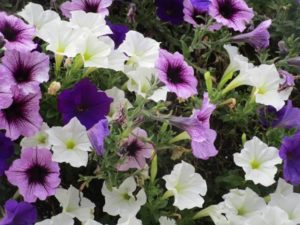
Flowering Hightstown.
DRIVE-BY NATURALIST, A GREAT EGRET: As I was driving home from Hightstown, I crossed the Millstone River, the boundary of East Windsor, Mercer County, and Cranbury, Middlesex County. There, I noticed a perched great egret, “Ardea alba.” Keep an eye out for nature. It is all around us.
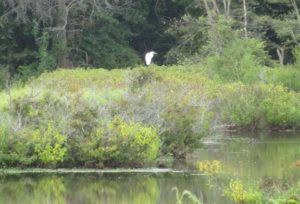
A great egret on the Millstone River. Here, the river is the boundary of East Windsor, Mercer County, and Cranbury, Middlesex County.
OCEAN TEMPERATURES: Atlantic Ocean temperatures on the New Jersey coast were about 72 degrees Friday, September 15.
SUNRISE/SUNSET: For September 17, Sunday, to September 23, Saturday, the sun will rise about 6:40 to 6:45 and set about 6:55 to 7:05. The fall equinox of nearly equal daylight and sunlight is September 22, Friday. For September 24, Sunday, to September 30, Saturday, the sun will rise about 6:50 a.m. and set about 6:45 p.m.
THE NIGHT SKY: The new moon is September 20, Wednesday. The next full moon is the Full Harvest Moon October 5, Thursday.
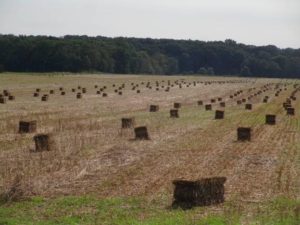
Harvest time it is. Here, hay being harvested on a farm in Cranbury, Middlesex County.
WEATHER: The National Weather Service forecasting station for the area is at http://www.weather.gov/phi/.
Joe Sapia, 60, is a lifelong Monroe resident. He is a Pine Barrens naturalist and an organic vegetable-fruit gardener. He gardens the same backyard plot as did his Italian-American father, Joe Sr., and his Polish-immigrant, maternal grandmother, Annie Poznanski Onda. Both are inspirations for his food gardening. Joe is active with the Rutgers University Master Gardeners/Middlesex County program. He draws inspiration on the Pine Barrens around Helmetta from his mother, Sophie Onda Sapia, who lived her whole life in these Pines, and his Grandma Annie. Joe’s work also is at @JosephSapia on Twitter.com, along with Facebook.com on the Jersey Midlands page.
Article and photos by Joe Sapia
Note: The yard references are to my house in the section of Monroe between Helmetta and Jamesburg in South Middlesex County. My yard is in a Pine Barrens outlier on the Inner Coastal Plain, the soil is loamy, and my neighborhood is on the boundary of Gardening Zones 6b (cooler) and 7a (warmer). Notes and photographs are for the period covered, unless otherwise noted.
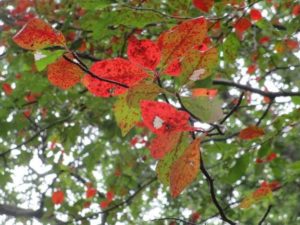 A black gum, “Nyssa sylvattica,” changes color at Cranberry Bog in the Pine Barrens around Helmetta.
A black gum, “Nyssa sylvattica,” changes color at Cranberry Bog in the Pine Barrens around Helmetta.
CHANGING COLORS IN THE PINE BARRENS AROUND HELMETTA: Black gum trees, ““Nyssa sylvattica,” are obvious with their leaves changing colors for the season. “Fall foliage,” meaning the changing colors as colder weather approaches, is a misnomer, because, here, in the Pine Barrens around Helmetta, changing colors are noticeable beginning about July 15 to 31. I look for the peak of the coloring October 13 in wet areas and October 20 in dry areas, but, really, it is impossible to pinpoint a peak. If there is even a peak, because there may not be a uniform turning of colors.
“OPIENKI” MUSHROOMS, PINE BARRENS AROUND HELMETTA: As I drove a paved road through Jamesburg Park today, I saw a car parked at the woods and a woman at the car. She wore yoga pants, a short-sleeve pullover shirt, and sneakers, pants untucked — not really dressed as a woodswoman. So, I took a guess at what she was doing.
Mushrooms? I asked.
She said yes.
What kind, honey mushrooms?, I said.
The woman — Lana, who lived a few miles away from the site — said she did not know the name to tell me. Then, I noticed what sounded to be an Eastern European accent.
“Opienki”? I asked.
Yes, she smiled. How did you know that name?
A grandmother from Poland, I said.
Lana is from the Ukraine. She was picking edible mushrooms of the genus “Armillaria,” known by Polish people as “opienka” singular and “opienki” plural. “Pien” means stump in Polish and these mushrooms grow along the stumps of dead oaks. Hence, they also are known as “stumpies” — and “tan and yellow stumpies” because of their color and, of course, where they are found. But the general public probably would know them best by their common name, “honey mushrooms.”
Lana had bags filled with mushrooms in her car. (See the photos, which she let me take.)
Journalisticly, I am publishing this to inform people. In a neighborly way, I am hesitant to publish this because PICK THE WRONG MUSHROOM AND, AT BEST, YOU WILL GET SICK, AND, AT WORST, YOU WILL DIE.
I am 60-years-old and have been in these woods my whole life, and have heard stories from them going back another 50 or 60 years to when my maternal family settled here, and I will confidently pick ONLY ONE mushroom in the Pine Barrens around Helmetta: opienka. In the Jersey Midlands as a whole, I will confidently pick ONLY TWO: the second one, a morel, which I am familiar with on the Piedmont — say, at such areas as Princeton and Sourland Mountain.
I am “somewhat confident” to pick two more. But I made it to 60 and “somewhat confident” does not cut it. Remember the adage: There are bold mushroom pickers and there are old mushroom pickers. There are no old AND bold mushroom pickers.
If one must pick mushrooms, three bits of advice, even for the experienced picker: One, know how to call emergency responders, telephone 911; two, the telephone number of New Jersey Poison Control, 800-222-1222; and three, save one mushroom, perhaps on your kitchen counter, so doctors know the mushroom one ate.
I said good-bye to Lana, warning her of ticks, which can pass along disease such as Lyme, and chiggers, which will get one itching, beginning about 36 hours after leaving the woods, and scratching like crazy for days. (Me, man who got chiggers a week ago, here, in the Pine Barrens around Helmetta. Me, stupid man because I was not thinking and did not avoid grassy areas.)
(Dedicated to Grandma Annie Poznanski Onda, born 1885 in Poland, died 1972 in the Pine Barrens around Helmetta. And a big thank you to Ralph “Rusty” Richards, woodsman extraordinaire of the Pine Barrens around Helmetta, who continues to be a local woods mentor to me.)
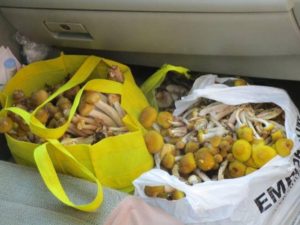
Lana’s “opienki” mushrooms in the Pine Barrens around Helmetta.
ALSO IN THE PINE BARRENS AROUND HELMETTA: Look for fall bloomers, such as asters. Joe Pye weed, “Eutrochium purpureum,” remains blooming – and will do so until about October. Queen Anne’s lace, “Daucus carota,” continues blooming to about November. The seed heads of punks, or cat-tails, genus “Typha,” were fluffing as summer passes.
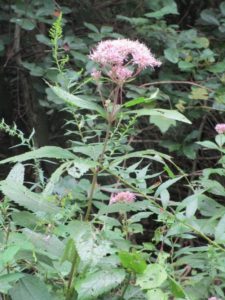
Joe Pye weed in bloom near the Ditch in the Pine Barrens around Helmetta.
CHIGGERS IN THE PINE BARRENS AROUND HELMETTA: I did a brief hike Friday, Sept. 1, and began itching around Sunday morning – chigger bites! Fortunately, I did not get a bad case, a bit of itching here and there on my legs. I first encountered chiggers, here, in about 2004. Some view chiggers as a Southern species moving north; Others will say we already had them up here. I knew of chiggers from hiking in the Pine Barrens down in South Jersey. The bottom line is they itch! So, I will scratch for a few days, then life will go on until the next round of chiggers. (A tip: Avoid grassy areas such as those I walked in on my hike. I just was not thinking.)
MA, GRANDPA, AND THE LOCAL PINE BARRENS: Perhaps I was not thinking of chiggers on Sept. 1 because my mind was elsewhere. Earlier that day, I had mailed in a donation to my church, Holy Trinity Roman Catholic Church in Helmetta, and a request for a Mass to be said in Grandpa Mike Onda’s honor October 11– the 100th anniversary of his death in Helmetta from tuberculosis at 35–years-old. He left a 32-year-old widow, Annie Poznanski Onda, and three children 5-years-old and younger. One of those children was my mother, Sophie Onda Sapia, who was 3 when her father died. Her only memory of her father in later years was of her with him at Shekiro’s Pond in Helmetta. September 1 was the 22nd anniversary of Ma’s death at 81 in 1995. On this anniversary, I visited Shekiro’s Pond.
PESTS IN THE YARD: Neighbor Tom DeRose contacted me on the night of Labor Day, wanting to show me something in his yard. So, in the dark with flashlights, Tom and I were looking into a hole – perhaps big enough to shove in a few golf balls – of yellow jacket wasps. Ugh! They have scared me since I was a kid playing Army in this same neighborhood with Eddie Kasubinski. I pointed down the street at “The Swamp,” where Eddie and I got attacked – not by an opposing army, but by “yellow jacks.” I ran up the street crying. My father heard me, rushed into the backyard, saw the yellow jacks attacking me, grabbed my Army jacket, which had yellow jacks in it, and threw it aside. A number flew out of the jacket. I had got stung twice. Yellow jacks can be aggressive and multiple stingers. So, I advised Tom to stay away from his side yard until the cold weather sets in or spray a pesticide into the hole.
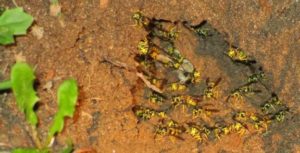
The yellow jacket nest in Tom DeRose and Trisha Miller DeRose’s side yard.
LAURINO FARMS: I was out in Monmouth County and stopped by Laurino Farms on Route 537 (between Laird and Swimming River Roads) in Colts Neck. There, I picked up a favorite of mine, white peaches, along with a jar of cranberry preserves. A shout out to Bobby Laurino, whom I saw briefly – personally, Bobby has patiently answered my gardening questions and he is an inspiration for me growing zinnias this year. And, more importantly, a shout out to Bobby for what he does for feeding the needy, including helping the Soul Kitchen restaurants (www.jbjsoulkitchen.org) in Red Bank and Toms River, founded by rock and roll star Jon Bon Jovi and his wife, Dorothea Bongiovi, who live in Middletown, Monmouth County, to support the needy. For example, Laurino provides space at his farm for Soul Kitchen to grow food organically. Dorothea said, “Bobby is an amazingly generous person, not only with his contribution of land to the Soul Kitchen so we could raise our own vegetables, (but) he is generous with his time, his knowledge, his spirit. I am not sure if all farmers are as optimistic as Bobby, but he has a positive can-do attitude that maybe all farmers need. Farming is an unbelievably difficult life, with many uncontrollable variables: temperature, rain, sun, insects (Bobby does not use pesticides), animals. I have enormous respect for anyone who grows food for others.” (And a shout out to Dorothea, who handles herself with class and humility. Over the summer, Dorothea received a Volunteer Leadership Award in the New Jersey State Governor’s Jefferson Awards for Public Service for her work with Soul Kitchen. “I was very surprised and humbled by the Jefferson award,” Dorothea said.)
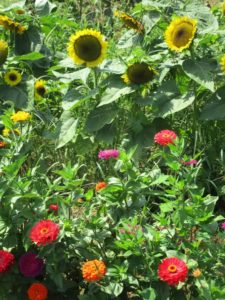
Zinnias and sunflowers at Laurino Farms in Colts Neck, Monmouth County.
DRIVE-BY NATURALIST, “BIDENS” FLOWERS: Although I know the yellow flowers of the genus “Bidens” are adorning unplowed farmland and disturbed areas, it still amazes me when I come across fields of these flowers. I was driving in southern Monroe and came across this batch, next to acres of soybeans.
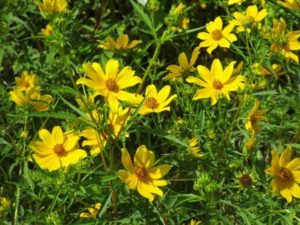
Yellow flowers of the genus “Bidens” in southern Monroe.
IN THE YARD AND GARDEN: The zinnias and Knock Out roses continue to bloom earnestly.
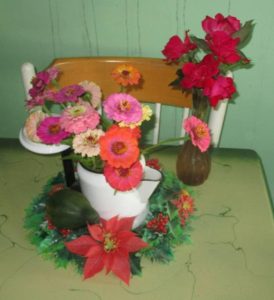
Zinnias, Knock Out roses, and a gourd, all from the my yard or garden, decorate the antique porcelain-top table in my kitchen. One of Ma’s old coffeepots is used as a vase.
MY BELOVED ZINNIAS: While still flowering wonderfully, the zinnias appear to have contracted powdery mildew. So, I will be dealing with this.
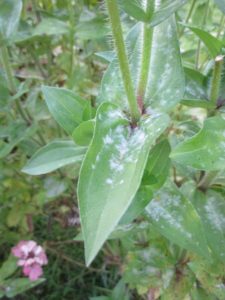
Apparently powdery mildew on the zinnias.
IN THE GARDEN: My summer crop, except for the zinnias, was a disaster. The sweet corn was undeveloped, probably because of too much rain and I should have planted in a bigger block to foster pollination, but it was harvestable and tasty. Too much rain translated into no cucumbers, no cantaloupe. Very few tomatoes, because something ate the tops off the plants.
MECHKOWSKI FARM: Timmy Mechkowski farms in Helmetta. He reported good crops of sweet corn, beets, stringbeans, carrots, broccoli, cabbage, and onions. “Tomatoes were decent until the end, when we starting getting the rain.” Timmy reported a bad year for peppers, potatoes, and blackberries. The Mechkowski farm is one of my favorite places.

Sitting on the front porch of his house, Timmy Mechkowski goes over his planting list.

Timmy Mechkowski’s dog, Abby, probably the most beautiful and most gentle dog I have ever met.
NAVESINK RIVER: The Navesink River drains about 95 square miles in the Red Bank area of Monmouth County. It abuts the hilly geological formation that separates the Inner and Outer Coastal Plains. The river sits on the Outer Coastal Plain side. These photos were taken downstream of the Ocean Bridge from the Middletown side. The bridge connects Middletown and Rumson. The Navesink River is one of my favorite places in the Jersey Midlands.
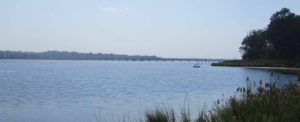
On the Navesink River, looking toward the Oceanic Bridge connecting Rumson, left, and Middletown, right.
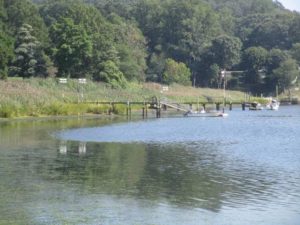
Along the Navesink River.
DRIVE-BY NATURALIST, GREAT BLUE HERON: As I was leaving the Navesink River, I noticed a great blue heron, “Ardea Herodias” – a large bird I am in awe of.
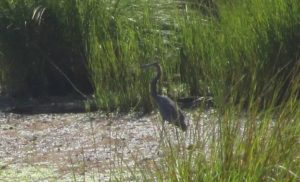
The great blue heron along the Navesink River.
BIG SKY COUNTRY, MONROE TOWNSHIP: As the Jersey Midlands continue to develop, there is more a loss of big sky views. But the area between the Applegarth and Wyckoff’s Mills sections of Monroe is still a holdout. Here, there are wonderful views over soy bean fields and cornfields.
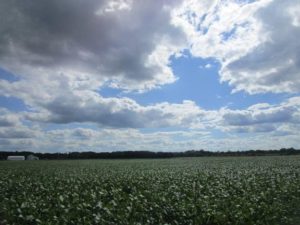
Between Monroe’s Applegarth and Wyckoff’s Mills sections, looking over a soybean field toward Route 33.

Between Monroe’s Applegarth and Wyckoff’s Mills sections, looking toward Cranbury, with corn growing to the right and soybeans to the left.
THE FLIP SIDE OF BAMBI: I have published photographs of beautiful deer in nature. I need to point out the flip side: deer on farmland and in garden. Years ago, I was talking to a farmer who grew corn on the state’s Assunpink Wildlife Management Area in western Monmouth County. The farmer paid no rent, but he had to leave a percentage of his crop to feed wildlife. The way I recall the story: “The problem is,” the farmer said, “the deer don’t know which 75 percent is mine and which 25 percent is theirs.” As Jersey Midlands nature writer John McPhee has written, “Deer, in my opinion, are rats with antlers, roaches with split hooves, denizens of the dark primeval suburbs. Deer intensely suggest New Jersey.”
OCEAN TEMPERATURES: Atlantic Ocean temperatures on the New Jersey coast were in the range of about 69 to 72 degrees during the weekend of September 9-10.
SUNRISE/SUNSET: For September 10, Sunday, to September 16, Saturday, the sun will rise about 6:35 to 6:40 a.m. and set about 7:10. For September 17, Sunday, to September 23, Saturday, the sun will rise about 6:40 to 6:45 and set about 6:55 to 7:05. The fall equinox of nearly equal daylight and sunlight is September 22, Friday.
THE NIGHT SKY: This week, in the pre-sunrise sky, I saw the constellation Orion for the first time this season – Colder weather is coming with the winter constellations. The moon is waning after the September 6 full moon. The new moon is September 20, Wednesday. The next full moon is the Full Harvest Moon October 5, Thursday.
WEATHER: The National Weather Service forecasting station for the area is at http://www.weather.gov/phi/.

Joey’s zinnias at the Hightstown Diner, in Hightstown, Mercer County.
Joe Sapia, 60, is a lifelong Monroe resident. He is a Pine Barrens naturalist and an organic vegetable-fruit gardener. He gardens the same backyard plot as did his Italian-American father, Joe Sr., and his Polish-immigrant, maternal grandmother, Annie Poznanski Onda. Both are inspirations for his food gardening. Joe is active with the Rutgers University Master Gardeners/Middlesex County program. He draws inspiration on the Pine Barrens around Helmetta from his mother, Sophie Onda Sapia, who lived her whole life in these Pines, and his Grandma Annie. Joe’s work also is at @JosephSapia on Twitter.com, along with Facebook.com on the Jersey Midlands page.
Article and photos by Joe Mish
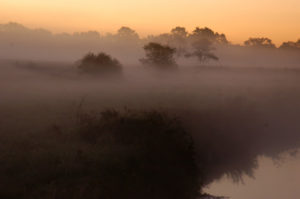 An orange sky rests upon the impenetrable white fog as dawn breaks over Holland brook on the first day of September. The predawn landscape is shrouded in a heavy mist so deep, only the treetops can be seen.
An orange sky rests upon the impenetrable white fog as dawn breaks over Holland brook on the first day of September. The predawn landscape is shrouded in a heavy mist so deep, only the treetops can be seen.
As September exhales the last warm breath of summer, it begins to inhale cool autumn air in a respiratory sequence of endless seasonal change.
With barely 9 days of autumn out of 30, the title to September is in summer’s name, despite the lien filed by fall for possession. The struggle that ensues is openly expressed in fits of alternate ownership, where autumn takes over with chilly nights while summer responds with beautiful warm days, indistinguishable from its July and August menu.
The engagement of warm summer days and cool autumn nights, in a battle for dominance, leaves the river’s flood plain covered with heavy morning mist. The impenetrable white fog hides everything except isolated tree tops to give the impression of a primordial soup that first gave rise to life on earth.
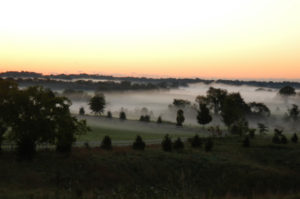
White mist rising up from the South Branch, submerges trees in a dense early morning fog, characteristic of the drastic day and night temperature changes in early fall.
As autumn appeals its case to the heavens, the sun begins to shift its position and rides lower in the sky, away from its high summer orbit. Evidence of this collusion is signaled as the dawn light colors the morning mist with every tint from gold thru orange to deep purple; a precursor to the colorful foliage that defines the fall season. The colors signal another vote for autumn’s plan to own September.
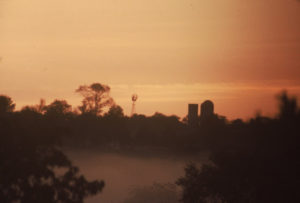
Except for the silhouette of farm building on the high ground, this scene has played out along the South Branch for thousands of years when autumn approaches.
Ultimately it is the stars in the heavens which have the final say, as they align to signal the exact moment of the autumnal equinox to find in fall’s favor. There is no chance of appeal, though summer still resists.
Offering blue skies and warm days, scraped from the bottom of it’s now empty quiver, summer attempts to keep the foliage from changing to a colorful no vote.
First to buy into autumn’s argument is Virginia creeper and poison ivy. Summer ignores their decision and counters that vines showed color back in August. A time clearly owned by summer and validated by consensus. It is when the black gum trees’ leaves began to turn a bright salmon color that summer’s brave stance began to waver. Here was a tree whose leaves began to light up the greenery like old fashioned lights tacked to the porch rail to celebrate the holiday season. Once the trees began to turn, summer knew its days were numbered.
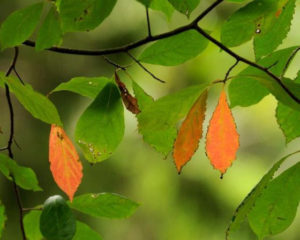
Black gum leaves mark the beginning of nature’s display of autumn color.
The stalwart oaks were the next to be counted as they sounded in favor of autumn, treating each fallen acorn as a separate vote. The deer found in favor of summer and began to eat all the fallen acorns in an attempt to cancel the oaks’ ballots. If summer was hard of hearing and the polling place rife with fraud, the oaks along with the sweet gum trees blinded the hillsides with color. Deep scarlet red oak leaves combined with a brilliant array of yellow, purple and old rose, star shaped sweet gum leaves. Norway and sugar maples chimed in with fluorescent red and yellow leaves. The final tally was overwhelming, a landslide in favor of autumn’s claim to September and an end to summer’s futile efforts to hang on.
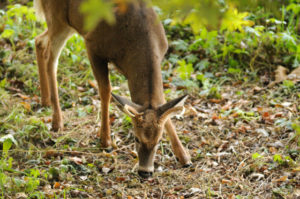
A young buck searches the ground for acorns in early September. Acorns are the number one food that deer love. when you see deer hanging around under a tree in early fall, notice that tree is more than likely an oak. Deer dine as we are supposed to, they eat what is in season.
Summer looked upon the flowers of the field to see the drooping heads and faded colors of the delicate muses it so carefully nurtured and who, in return, stood by summer’s side until their death. Summer was finally moved to surrender its claim of September to autumn. With a last warm breath, summer whispered a vow to return, even before the final days of the next spring.
Author Joe Mish has been running wild in New Jersey since childhood when he found ways to escape his mother’s watchful eyes. He continues to trek the swamps, rivers and thickets seeking to share, with the residents and visitors, all of the state’s natural beauty hidden within full view. To read more of his writing and view more of his gorgeous photographs visit Winter Bear Rising, his wordpress blog. Joe’s series “Nature on the Raritan, Hidden in Plain View” runs monthly as part of the LRWP “Voices of the Watershed” series. Writing and photos used with permission from the author.
Article and drawing by Maya Fenyk, age 13
Hello! I am Lynx Rufus, but you can call me Blossom the Bobcat. I am New Jersey’s only native wildcat, and have been on New Jersey’s endangered species list since 1991. Sightings of me in the Lower Raritan Watershed and throughout the state are increasing, but are still rare.
You might think “Oh, bobcats must survive just fine. They are at the top of the food chain. They have no predators.” I am sorry to say, that’s just not true. Some of my predators are mountain lions, coyotes, foxes, owls, wolves and humans. I can’t say I blame them as I also prefer a carnivorous diet. My prey includes rabbits, rats, squirrels, ground-nesting birds, turkeys and even small or sick deer. But predator threats are not my biggest concern.
My species used to be abundant and flourishing in the coniferous and mixed forests of New Jersey until humans started deforesting our homes. Clearing land for retail, corporate and housing developments has a huge impact on my survival. And disruption of our habitat by pipelines has huge impacts on us and other endangered, threatened and special concern species. Other issues that affect me are hunting and being hit by cars. Getting hit by cars, development and pipeline installation are linked. Fragmentation of my habitat makes it hard for me to find shelter from the weather, cover for hunting and raising my babies, and forces me and my family to cross roads to find our dinner and safe spaces to hide. Please slow down through forested areas! When humans ruin my home, push me onto their roads, and drive too fast through the woods it really gets my angry purring going.
The New Jersey Department of Environmental Protection’s Endangered and Nongame Species Program’s Bobcat Recovery and The Nature Conservancy’s Bobcat Alley are both doing a great job restoring bobcats in New Jersey, but plans for pipelines and proposals to reduce protections under the state’s Freshwater Wetlands Protection Act and the federal Clean Water Act put our population recovery into question.
I must head to my den to check on my kittens, but I want to let you humans know how important it is to keep track of the numbers of my species. To report a bobcat or other endangered species sighting, please contact NJDEP. Thanks! And I say that with a final meow!
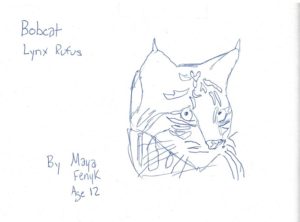
NJDEP Announces Response Strategy for Harmful Freshwater Algal Blooms, Seeks Public’s Help to Identify Suspected Incidences
Statewide Effort to “Avoid It and Report It” Includes Online Form for Reporting Suspected Blooms
Seeking to minimize health risks for people and animals, the Department of Environmental Protection (DEP) has developed a strategy for a unified statewide approach in responding to incidents of Harmful Algal Blooms (HABs) in freshwater bodies across the state.
Under the new “Avoid It and Report It” effort, anyone who sees a suspected bloom resulting from cyanobacteria may contact DEP through its toll-free hotline or the WARN NJDEP app for smartphones and tablets. In addition, a new website ( http://www.state.nj.us/dep/wms/HABS.html) has been launched to coordinate important information and response activities. Alerting DEP to the suspected blooms quickly can help protect public and animal health and freshwater resources.
“Expanding our ability to respond to Harmful Algal Blooms, establishing preparedness procedures, and making information about these blooms more readily available to the public enables DEP and its partners to better protect the health of those who use New Jersey’s lakes and streams for recreation,” said Dan Kennedy, Assistant Commissioner for Water Resources Management.
Most algal blooms observed in New Jersey’s waterways are harmless and are not cyanobacteria. They result from too many nutrients causing excessive blooms of naturally present algae.
Cyanobacteria, also known as blue-green algae are usually a bright green, but can also appear as spilled paint, “pea soup,” or as having a thick coating or “mat” on the surface. They can often be confused for typical algae blooms. Cyanobacteria are also naturally present in lakes and streams in low numbers. Under suitable environmental conditions – sunlight, high nutrients, warm temperatures and calm water – dense cyanobacterial blooms can form. Cyanobacterial blooms do not always produce toxins, but when they do the blooms can pose a risk to people, pets, livestock and wildlife if exposure occurs by ingestion, inhalation of contaminated water, or dermal contact. Rashes can occur when cyanobacteria cells come in contact with skin.
When a suspicious bloom is observed, people are advised to Avoid It and Report It by following these steps:
. Avoid contact with water in the vicinity of the bloom, especially in areas where the bloom is dense and forms scums;
. Do not drink or consume the water;
. Do not eat fish from the waterbody;
. Keep pets and livestock away from the water;
. Do not allow animals to drink the water, eat dried algae, or groom themselves after coming into contact with the water;
. People, pets and livestock that come into contact with a bloom should rinse off with fresh water as soon as possible;
. Seek medical attention or a veterinarian if a person or animal is experiencing adverse health effects after exposure to a bloom; and
. Report a suspected HAB by calling the DEP Hotline at 1-877-WARNDEP (927-6337) or send a mobile alert through the WARN NJDEP mobile app (available via iTunes, Google Play or Windows Phone).
The new response strategy, developed jointly by the DEP and the state Department of Health (DOH), with technical input from the state Department of Agriculture, protects the public from risks associated with exposure to cyanobacteria and related toxins.
While the primary focus of the strategy is protection of human health, it also provides information on how to prevent exposure to domestic animals and livestock. The New Jersey Water Monitoring Council and the U.S. Environmental Protection Agency’s Office of Water provided technical input and review of New Jersey’s HABs strategy.
The response strategy covers freshwater lakes, rivers, and streams with potential public access, recreational use, and bathing beaches (including licensed beaches). While these waterbodies may also be sources of drinking water in New Jersey, the focus of the response strategy is recreational use. DEP works closely with drinking water systems to plan for HABs as well as all other drinking water emergencies.
The strategy includes:
. Procedures for reporting suspected cyanobacterial HABs;
. Information regarding which agencies/organizations are responsible for responding to an HAB report and what actions are to be taken;
. New Jersey recreational risk thresholds;
. Acceptable methods for conducting monitoring and analysis;
. Recommended advisory language; and
. A process for developing a HAB research plan.
Based on information from the U.S. Geological Survey, 19 states had public health advisories for cyanobacterial blooms in August 2016. With the release of the new response strategy, New Jersey joins more than 30 other states who have developed HAB strategies and/or HAB public awareness informational materials. So far this summer, New Jersey has responded to nine confirmed or suspected HABs in lakes and streams.
The new NJDEP HAB-focused website, found at http://www.state.nj.us/dep/wms/HABS.html , contains information on both freshwater cyanobacterial HABs, and a variety of marine water HABs. Highlights include an electronic cyanobacterial HAB Reporting Form, downloadable Advisory signs and flyers for use for HAB events, a general cyanobacterial fact sheet, and a more detailed fact sheet on recreational exposure and health effects related to cyanobacterial HABs. General information about cyanobacterial HABs, what to do if people or pets are exposed, links to the EPA and U.S. Centers for Disease Control’s HABs websites and other resources, as well as a gallery of both HAB and non-HAB photos of lakes and streams, are also provided.
For questions regarding the freshwater harmful algal bloom strategy, call DEP’s Bureau of Freshwater and Biological Monitoring at (609) 292-0427 or email mailto:njcyanohabs@dep.nj.gov
To learn more about the NJ Water Monitoring Council, visit http://www.nj.gov/dep/wms/wmcchome.html
For more about DEP’s Division of Water Monitoring and Standards, visit http://www.nj.gov/dep/wms/
The new NJDEP HAB-focused website, found at http://www.state.nj.us/dep/wms/HABS.html, contains information on both freshwater cyanobacterial HABs, and a variety of marine water HABs. Highlights include an electronic cyanobacterial HAB Reporting Form, downloadable Advisory signs and flyers for use for HAB events, a general cyanobacterial fact sheet, and a more detailed fact sheet on recreational exposure and health effects related to cyanobacterial HABs. General information about cyanobacterial HABs, what to do if people or pets are exposed, links to the EPA and U.S. Centers for Disease Control’s HABs websites and other resources, as well as a gallery of both HAB and non-HAB photos of lakes and streams, are also provided.
Article and photos by Joe Sapia
Note: The yard references are to my house in the section of Monroe between Helmetta and Jamesburg in South Middlesex County. My yard is in a Pine Barrens outlier on the Inner Coastal Plain, the soil is loamy, and my neighborhood is on the boundary of Gardening Zones 6b (cooler) and 7a (warmer). Notes and photographs are for the period covered, unless otherwise noted.
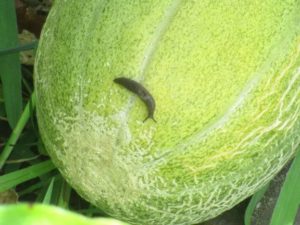
This photograph – that of a slug on a cantaloupe — basically sums up my garden’s summer fruit and vegetable crop. Slugs like moisture. And it was just a wet season.
GARDEN VOICES, NO.1: “It has simply been too wet for most things,” said Bob Eriksen, a retired biologist with the state Department of Environmental Protection who gardens in Warren County, just outside of the Jersey Midlands. “I have had groundhog issues in our garden, as well as deer. The deer are early — when the mulberries are hitting the ground, they spend time poking around our yard nibbling on everything. The groundhogs have been a major issue, eating everything from tomatoes and peppers to petunias. I have removed eight, so far, and believe there are still at least two more. I did not trap any last summer, but the summer before I caught nine.”
IN THE GARDEN: Aside from the zinnias and Knock Out roses, both of which continue to produce nicely, I pretty much have given up on the rest of the summer crop. Not one cucumber! And I fear not one cantaloupe will ripen properly. But the fall crop of carrots and lettuce, planted in early August, are coming up nicely.
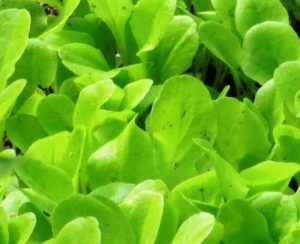
Here comes the fall lettuce crop.
GARDEN VOICES, NO. 2: Paul Migut, a childhood friend and one of my gardening mentors, checked in from South River, Middlesex County. Paul, who is in his early 60s, has been food gardening since childhood: “I’d say this wasn’t the best of year for the vegetable garden. I’d say 3 out of 5.
Bush beans producing about 20 percent of previous month. Some plants drying up, branches showing signs of ‘old age’ (brown, brittle). Pickles still producing, but much slower, and also appear to be drying despite watering at 6:30am. Zucchini, a total waste as borers devoured the stalks.
Eggplants producing, but not as plump as prior years. Rutgers tomatoes small, (good color and that Jersey flavor!). Yellow (acid-free) producing fairly well, though appear a bit delicate with signs of spots, imperfections, but rather juicy. Radishes done. And the ‘mistake’ purchase of turnip (Purple Top White Globe, ‘Brassica rapa’) are still leafy, bushy, and still getting bigger — some over 4 to 5 inches diameter. Pulled more weeds than crops yesterday! Now to the house- rotate use of de-humidifier water between hydrangea in front of house and to refill backyard birdbath.” Paul is a great food gardener, making a not-so-good food garden year still a good year.
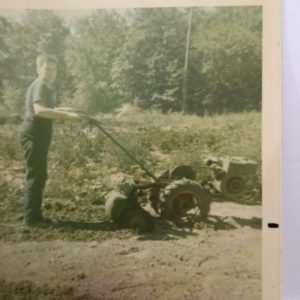
Circa late 1960s, Monroe Township – Paul Migut with an 8-horsepower roto-tiller at the huge garden of his uncle, Stanley “Pon” Ceslowski.
AROUND THE YARD: I was harvesting zinnia in the backyard garden when a large shadow passed over the backyard. I looked up and only a few yards away flew two turkey vultures, “Cathartes aura.” Usually, I see them soaring, riding the currents, rather than being nearby. I did not smell any dead animal for them to scavenge. So, perhaps they were perched nearby and I startled them.
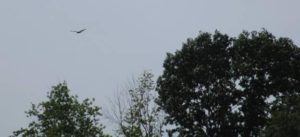
This turkey vulture flew off while I was in the backyard.
CATBIRDS AND CAT: I was doing some outside painting when a ruckus interrupted me. About four catbirds, “Dumetella carolinensis,” converged in the shrubbery behind me, next to the street. Underneath the hedges was the neighborhood cat, feasting on what was once part of the catbird clan.
DRIVE-BY NATURALIST: I was driving across the Swimming River Reservoir on the boundary of Holmdel and Colts Neck in Monmouth County and noticed two great egrets, “Ardea alba,” so I stopped and shot photos of one with Canada geese, “Branta canadensis.”
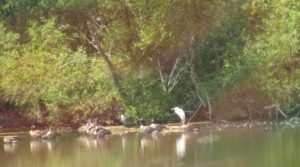
A great egret and Canada geese on the Swimming River Reservoir in Monmouth County.
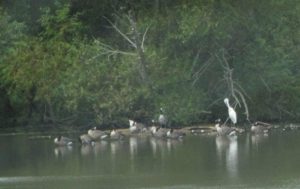
Another view of the great egret and Canada geese on the Swimming River Reservoir.
SEA BRIGHT BEACH: The Atlantic Ocean had a bit of a chop on the afternoon of Tuesday, August 29, at Sea Bright, Monmouth County, the surf tussled by the wind — sustained at about 10 to 13 knots per hour (a “gentle breeze” to “moderate breeze”) and gusts up to 14 to 19 KPH (“moderate breeze” to “fresh breeze”) about 3:30 to 4 o’clock, all out of the East Northeast, as recorded at nearby Sandy Hook. (Honestly, I thought the wind was blowing harder at Sea Bright.) Flags were extended, the surf rough, and foam, created by an agitated ocean, covered the surf line. Plus, it was raining. …But it was OK, that is what nature is about. And I had the beach to myself!
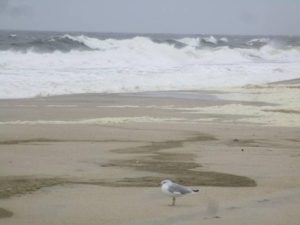
On this day at the beach in Sea Bright, Monmouth County, whitecaps were on the Atlantic Ocean, the surf churned, and the agitated ocean produced foam covering the surf line. It was kind of a day for the birds – or beach naturalists.
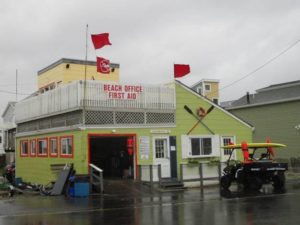
Flags at the Sea Bright Ocean Rescue Headquarters show the force of the wind.
SEPTEMBER AT THE SHORE: The traditional Jersey Shore summer season is the Memorial Day Weekend to the Labor Day Weekend. So, Labor Day Monday, September 4, would mean it is all over. Wrong! Remember the Shore secret, September is the best month at the Shore – less people, warm air and Atlantic Ocean temperatures, soft sunlight. But be extra careful if going into the ocean when lifeguards are not on duty.

2013, September, at the Atlantic Ocean in Asbury Park.
YELLOW FLOWERS IN THE FIELDS: The “Bidens” genus flowers are blooming nicely on unused farmland and disturbed areas. I vaguely remember hearing a story this yellow flower is not native to New Jersey, first being discovered in the state along railroad tracks at Camp Kilmer near New Brunswick in the post-World War II or Korean War years, suggesting it was transported from its native southern United States via railroad. I am going to take a guess and identify the species as “aristosa.” (But this historical and botanical information would have to be verified.) Basically, it is a weed — although a colorful one that brightens fields this time of year.
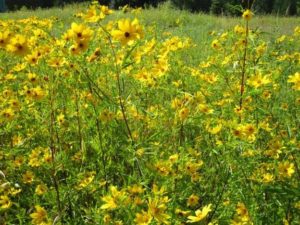
“Bidens” wildflower growing in South Brunswick, Middlesex County.
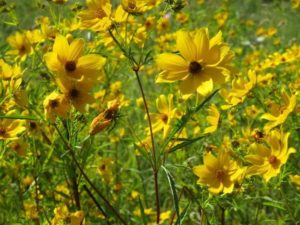
More of the “Bidens” wildflower in South Brunswick, Middlesex County.
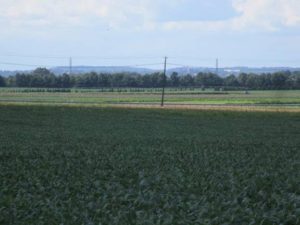
Where the generally flat Coastal Plain meets the rolling hills of the Piedmont — In the foreground is a soybean field on the boundary of Cranbury and Plainsboro in Middlesex County on the Coastal Plain, or more specifically the Inner Coastal Plain. In the distance haze are the rolling hills of Princeton, Mercer County, on the Piedmont. The Jersey Midlands are filled with stories of geology, flora, fauna, and, especially if we turn off outside lighting, the Night Sky.
COASTAL PLAIN BODIES OF WATER: Between the soybean field and the hilly ground in the previous photograph is a 23-acre pond in Plainsboro. The name on the sign, “Mill Pond Park,” says a lot. Its name suggests the pond was built, by damming Cranbury Brook, to form a power source for a mill. Most, if not all, bodies of water on the generally flat Coastal Plain are human-made.
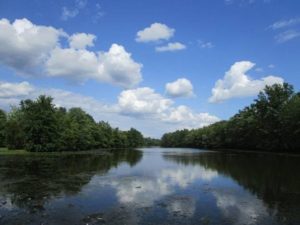
Plainsboro’s Mill Pond
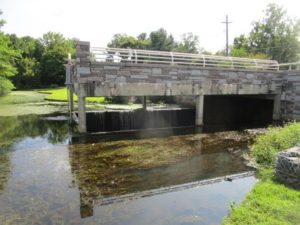
The dam that holds back Cranbury Brook to form Plainsboro’s Mill Pond.
A TALE OF TWO DEER: As I drove through Thompson Park in Monroe, I noticed a white-tail deer, “Odocoileus virginianus,” buck. He had a beautiful 10-point, velvet-covered rack. He was not free. Instead, he was confined behind a fence as part of the park zoo. Later that day, I saw another beautiful buck, this one on a section of Sourland Mountain in Montgomery, Somerset County. He roamed freely in a rural area of woods and farmland. But how free is “free”? Assuming the status of the two deer does not change, the zoo buck will be safe during hunting season, but the Sourland Mountain deer may wind up as someone’s meal or trophy.
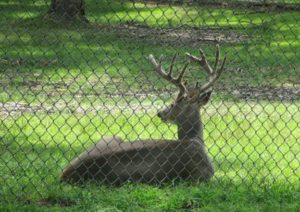
The Thompson Park Buck
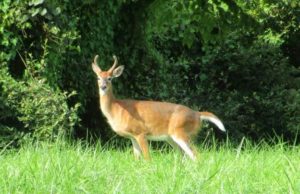
The Sourland Mountain buck.
FOR LAWN LOVERS, BLEGGGGGHHHH!: As you probably know, I dislike trophy lawns – basically, non-native wastelands filled with pollutants. Better to go green – go organic, go with native plants instead of a lawn, create high-grass wildlife patches, grow vegetables, or plant annual flowers that attract pollinators. But if you must…. Now is the correct time to seed lawns – as early in September as possible, not later than mid-September. This time of year provides for good seed growth, while competitive weeds are no longer growing. See the Rutgers University Cooperative Extension Service “Seeding Your Lawn” fact sheet, https://njaes.rutgers.edu/pubs/fs584/.
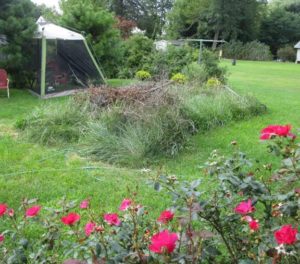
A wildlife patch in my neatly kept, but un-trophy-like, lawn.
GARDEN VOICES, NO. 3: Priscilla “Peppy” Bath, who gardens in Hamilton, Mercer County, knows about my quest to eliminate lawn in favor of garden. She checked in from vacation in Germany’s Black Forest. “I took a walk this morning and the house across from my hotel has no grass at all, just a beautifully maintained garden. It has flowers and vegetables, no weeds. Knock Out roses, cosmos, mountain pink, lots of lettuce, green beans, tomatoes, zucchini, and bare spaces where other already-harvested vegetables were. Perhaps this is what you are striving for.”
LEECHES: Sophie Onda Sapia used to tell me about leeches when she was a kid in the Pine Barrens Around Helmetta, where she lived all her 81 years, from 1913 to 1995. Ma said sometime one or more would latch onto one when swimming in the local waters. I have been around these waters all my 60 years – blessed to still walk afield where my maternal family has walked more than 100 years, despite New Jersey urbanization – and never recall pulling a leech off me. But I saw some chatter the other day on the “Jersey Pine Barrens” Facebook.com page about the “unusual amount” of leeches encountered, this year. Thoughts?
GRIGGSTOWN FARM: I stopped at Griggstown Farm near the Delaware and Raritan Canal in Franklin, Somerset County, and bought some goods – sweet corn, tomato, etc. Of course, I shot photos. More information, https://griggstownfarm.com/.
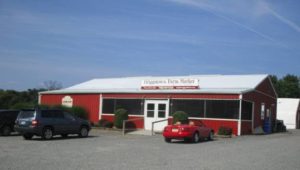
The market at Griggstown Farm in Franklin, Somerset County.
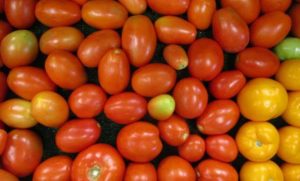
Tomatoes at Griggstown Farm.

Griggstown Farm’s cookbook library.
OCEAN TEMPERATURES: Atlantic Ocean temperatures on the New Jersey coast were in the range of about 72 to 74 degrees Thursday, August 31.

A lifeguard boat at Sea Bright, Monmouth County.
SUNRISE/SUNSET: For September 3, Sunday, to September 9, Saturday, the sun will rise about 6:30 a.m. and set about 7:20 p.m. For September 10, Sunday, to September 16, Saturday, the sun will rise about 6:35 to 6:40 a.m. and set about 7:10.
THE NIGHT SKY: The Full Corn Moon is on the Sept. 5-6, Tuesday-Wednesday, overnight.
WEATHER: The National Weather Service forecasting station for the area is at http://www.weather.gov/phi/.
UPCOMING: September 9 and 10, Saturday and Sunday, 10 a.m. to 5 p.m., the state Department of Environmental Protection’s Wild Outdoor Expo at the Colliers Mills Wildlife Management Area, Jackson, Ocean County, WildOutdoorExpo.com.

The zinnias from the garden keep on giving. Here, at a friend’s house.
Joe Sapia, 60, is a lifelong Monroe resident. He is a Pine Barrens naturalist and an organic vegetable-fruit gardener. He gardens the same backyard plot as did his Italian-American father, Joe Sr., and his Polish-immigrant, maternal grandmother, Annie Poznanski Onda. Both are inspirations for his food gardening. Joe is active with the Rutgers University Master Gardeners/Middlesex County program. He draws inspiration on the Pine Barrens around Helmetta from his mother, Sophie Onda Sapia, who lived her whole life in these Pines, and his Grandma Annie. Joe’s work also is at @JosephSapia on Twitter.com, along with Facebook.com on the Jersey Midlands page.
Dear Friends of the Lower Raritan Watershed –
Today is the kick-off the the new school year for the watershed’s younger residents. What do our kids learn about hydrology in schools these days? One of the first things most 3rd graders learn in earth science is that water runs downhill. By 6th or 7th grade, kids are making the connection between pollution of waters uphill and contamination of larger waterways in lower lying areas as the polluted water flows downhill. The LRWP thinks that rationale ought to be enough to include small river tributaries, headwaters and wetlands under the federal Clean Water Act to ensure protections for the waters of the United States (WOTUS). We let the EPA know as much in our public comments to their notice of proposed repeal of protections for these areas.
While the LRWP is concerned with impacts of the rollbacks of protections on our drinking water supplies (and on flood storage and wildlife habitat) we are even more concerned about future climate change impacts on water quality in our watershed. A recent study suggests that because climate change will lead to more rain in places like New Jersey and the Northeastern US (and India, China, and Southeast Asia), water quality in these places will decline. In a nutshell this study makes the link between increased rainfall leading to more pollutants in our waters uphill leading to eutrophication (an over-abundance of nutrients) in the waters downhill.
The LRWP was founded to improve our understanding of water quality in the watershed, and to start to track the impacts of climate change on our water quality over time. Join the LRWP community on Monday September 18 (World Water Monitoring Day) from 5:30-7:30 pm in New Brunswick’s Boyd Park for monitoring, picnicking and celebration of working toward our goals. Bring your own picnic or something to share. We’ll supply beverages, paper products and dessert. Friends and family members welcome (RSVPs requested). And if you have a story to share about how the Raritan River is important to you, let us know. We are looking for 4-5 people to tell their stories.
Wishing the students in the watershed all the best for a wonderful school year,
Heather Fenyk, President
Lower Raritan Watershed Partnership





















































































